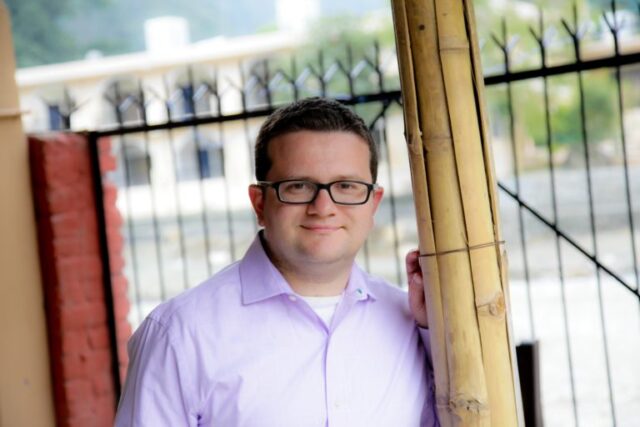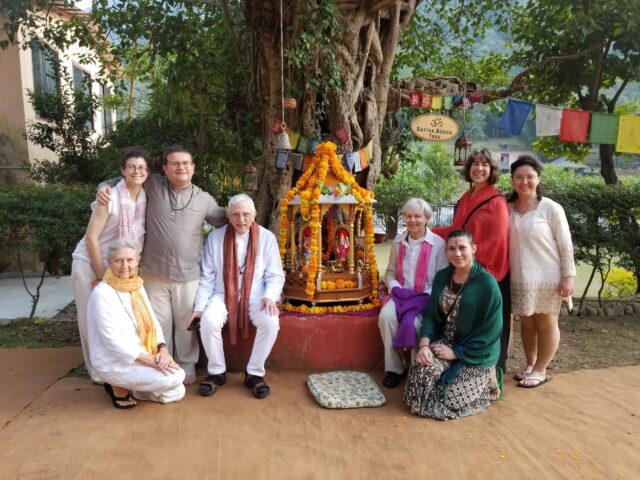We pride ourselves on having an incredible team here at Pollack Peacebuilding Systems, and so we decided to do a spotlight blog series that will feature all of the cool things our team is up to. The first interview was with Henry Yampolsky, one of our consultants who leads a yoga and mindfulness-based peacebuilding training called The Radical Peacemaking Program. Henry’s program completed its second year this past November in India.
Motorcycles and Mindfulness
 What do motorcycles have to do with mindfulness? For Henry, the exhilarating mode of transportation drove him to the doorstep of a mindful life. He was working as a trial lawyer in Philadelphia, and he was becoming disillusioned with his career. He also wanted passion in life that so many of us crave, yet never go after.
What do motorcycles have to do with mindfulness? For Henry, the exhilarating mode of transportation drove him to the doorstep of a mindful life. He was working as a trial lawyer in Philadelphia, and he was becoming disillusioned with his career. He also wanted passion in life that so many of us crave, yet never go after.
Henry discovered that riding motorcycles was a way he could find some excitement. One day he wasn’t feeling well and decided against going for a ride. Instead, while browsing Amazon, he came across a documentary called “The Highest Pass”, which chronicles spiritual leader Anand Mehrotra as he leads a motorcycle trip through the highest passes in the Himalayas.
“The movie was really about facing your fears and some critical yogic teachings on living a full life” Henry explains. The film deeply moved Henry, and so he looked Anand Mehrotra up on the internet. As it turned out, the spiritual leader was soon going to be teaching at a retreat in the United States. Henry and his wife went and began spending time with their newfound mentor. They eventually made the decision to travel to India to study the philosophy of yoga with Anand Mehrotra and become yoga teachers.
After his time in India, Henry knew he couldn’t return to things as they had been. He felt like he had been adding to conflict in the past, and he was now determined to contribute to building peace. So, six years ago he began his journey of becoming a conflict resolution consultant. He knew he wanted to bring the teachings of yoga and the things he learned from Anand Mehrotra to the forefront of his life, and the lives of other people.
The first program he created is called “Dis-Solving Conflict From Within”, which is a mindfulness-based conflict resolution program. Feeling this program could be added to, he then designed “Mindful Mediation”, which incorporates the teachings of yoga and mindfulness into a mediation training. He was eventually invited to speak about what yoga can teach us about conflict resolution at the Sattva Summit in Rishikesh, India; the birthplace of yoga.
The Radical Peacemaking Program
 From his own experience, Henry knew how powerful it would be to bring others to this sacred place in the world. The Radical Peacemaking Program was then born. This past November marked the second year of the intimate event; only 10 people attend, and it is kept small intentionally in order to provide a space where people feel comfortable with each other.
From his own experience, Henry knew how powerful it would be to bring others to this sacred place in the world. The Radical Peacemaking Program was then born. This past November marked the second year of the intimate event; only 10 people attend, and it is kept small intentionally in order to provide a space where people feel comfortable with each other.
Attendees complete some reading before the trip, and then they participate in different teachings and exercises while at the training. The experiential part of The Radical Peacemaking Program is very important; Henry explains, “it’s not just about the intellectual understanding of something, its about really experiencing these teachings on a deep level.”
Henry says the biggest takeaway for him from this training is being able to witness people having profound realizations about their lives and how they show up within their relationships and for their clients. He says there are sometimes tears as people have intense moments of recognition about how they’re living their lives.
Start Within
At the beginning of our conversation, Henry explained that before he began discussing the program with me, he wanted to touch on the importance of the word “radical” within his Radical Peacemaking Program. “Radical” comes from the Latin language and refers to the idea of a root or source. Henry then tells me that the core idea of his peacemaking program is to go to the source of peacemaking, which is something that is within each of us.
What does this mean, exactly?
Henry clarifies, “The idea behind this program is for us as peacemakers, to first and foremost, show up as peace.” When I accidentally quoted Gandhi’s famous quote, “be the change you wish to see in the world”, we briefly chatted about how that quote captures the essence of the program.
In order to ask the people we work with to create peace in their lives, we must know peace ourselves. Not that you have to become someone who spends all day meditating (although go ahead, if that calls to you), but it is important for mediators to have experienced moments of peace through mindfulness, meditation, yoga, or any of the countless other ways people consciously find space from their thoughts and feelings.
If, as mediators, we can show up to work with clients in a peaceful and conscious way, we signal to our clients that we are there to help them achieve their own peaceful state. Simple things such as directing your focus to your breath when you feel yourself getting overwhelmed with a tough client can help shift you into a more present and peaceful state. Finding some kind of personal practice of yoga, meditation, or any kind of mindfulness will eventually lead to more moments of peace, even if they seem to only occur while we are practicing, and sometimes not at all, at the beginning.
Why Yoga?
Henry’s training has such a large focus on yoga because it is more than just a way to stretch our bodies; it is “an ancient technology for connecting with other people and expanding beyond our own physical form”, as he explains. For those who don’t know much about yoga, there’s a whole philosophy that includes things such as:
- Ahimsa; a principle meaning non-violence
- Asteya; a principle meaning non-stealing
- Satya; a principle meaning truthfulness
These are only a few out of the group of yogic principles. Their definitions are fairly broad, meaning “Ahimsa”, or non-violence, may mean physical violence, but can also mean things such as hurtful words to a coworker, or even violence towards oneself via harsh, negative self-talk. You don’t have to dig very deep to see how this philosophy complements conflict resolution. Maybe one disputing party is stealing peace from their coworkers by instigating drama, or someone is telling different versions of a story to different people and it is causing tension.
By connecting with our own bodies through the yoga poses, we can experience these different principles within ourselves, which is the first step to bringing them to the lives of others.
Why Mindfulness?
Henry and I spent some time talking about his definition of mindfulness, and his visual metaphors were new and exciting. He explained that he experiences mindfulness as a kind of emptiness, but he quickly clarified that he is still fully engaged with his life; surely even more so than before his journey into mindful living. The emptiness just comes with no longer chasing every thought and emotion down the rabbit hole and being completely consumed with the things happening in his life.
To explain this concept further, Henry provided the image of a movie theater. He explained that before devoting himself to mindfulness, he starred in the movie of his life: he was fully attached to thoughts and events and they greatly impacted his mood and levels of peace. Now, he is an attendee at the theater. He snacks on popcorn and soda while becoming engaged with the story unfolding in front of him, but he eventually gathers his things and heads home, undisturbed by the events that just took place.
We settled on the definition of “engaged, not entangled” to describe Henry’s experience of mindfulness.
Henry then explained that in Western culture, we view mindfulness as a way to feel better or handle stress in a calmer way. While these are wonderful side effects of the practice, they are not the core reason why we should be practicing. Meditation, yoga, and any kind of mindfulness are all tools for us to recognize that we are all one. The word yoga can even be interpreted from the Sanskrit language to mean “union”. The union of body, mind, and spirit, yes; but also, as Henry described, the union of “expanding our definition of ourselves to include others.”
Imagine if every person on this planet had a deep understanding of the idea that when we hurt someone else, we hurt ourselves, because we are all so deeply connected. We believe there would be less conflict in the world, and when it did still occur, we would eagerly and actively participate in healing whatever needs to be healed to move forward. For now, we hope more people can take advantage of inspiring opportunities like Henry’s Radical Peacemaking Program in order to continue bringing more peace to this world.
Additional Resources
If the topics discussed in this interview are of interest to you, here are some resources to check out:
- Henry’s Ted Talk
- Living Peace Institute Website (Henry’s Organization)
- “The Highest Pass” documentary — available on Amazon Prime
- “Inner Engineering” book by Sadhguru
- “Untethered Soul” book by David Singer
- “The Power of Now” and “A New Earth” books by Eckhart Tolle

